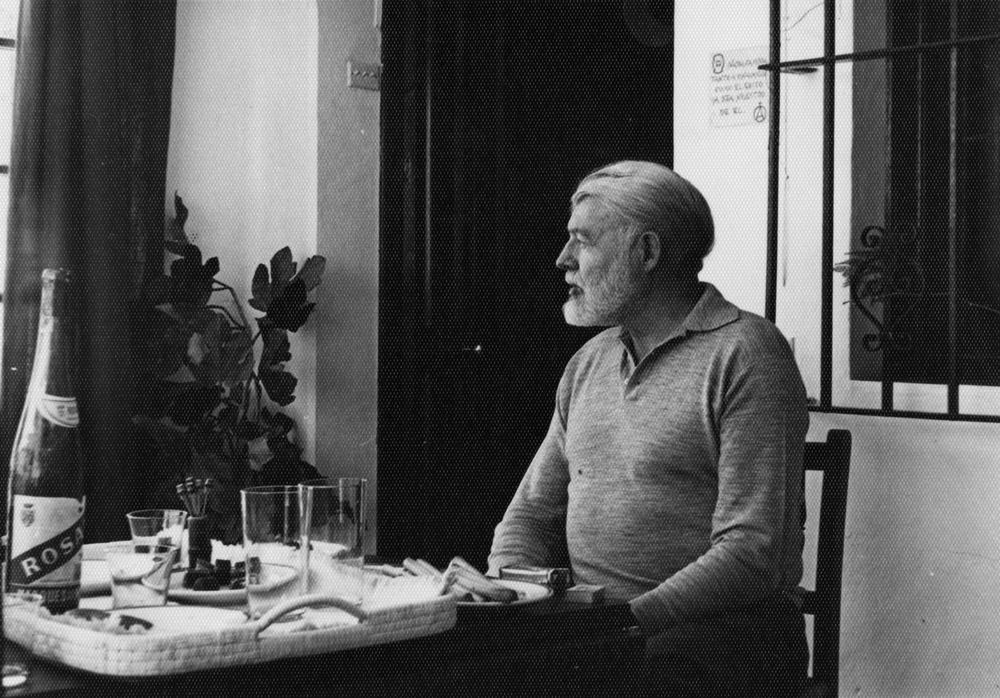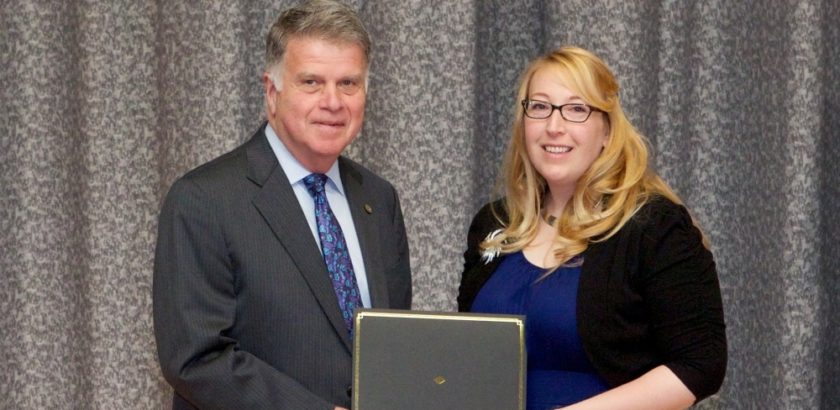by Laurie Austin, Audiovisual Reference Archivist
In conjunction with Public Service Recognition Week, the Archivist of the United States (or “AOTUS,” as he’s known throughout the National Archives) presented awards to employees and volunteers across the National Archives for exceptional work they achieved over the past year. [Check out the AOTUS’s blog here.] We were thrilled that our very own volunteer, Meghan Testerman, was awarded the Weidman Outstanding Volunteer Service Award for her work on the Ernest Hemingway Photograph Collection.

Archivist of the United States David Ferriero presents Kennedy Library volunteer Meghan Testerman with the Weidman Outstanding Volunteer Service Award at Archives II in College Park, MD, 7 May 2014.
Megh contacted us out of the blue in the fall of 2012 to ask if we had any short-term archival projects that she could do while her husband finished up his master’s degree at a local university. She agreed to take over work on the Ernest Hemingway Photograph Collection in the effort to finish describing the remaining 25% of photographs—approximately 2,500 images. The work involved researching every photo to identify the people, places, occasions, dates, and copyright holders whenever possible, and then writing descriptions of each image in the database. It also included updating box and folder numbers to make the collection more user-friendly.
There was a good reason why this portion of the collection was left for the end—it was by far the most daunting. Megh’s predecessors had all done their share of detective work, but this portion of the collection required a master sleuth. The photos were primarily of Hemingway’s travels in Spain in the 1950s, as well as the photos he amassed for writing his bull fighting novels. Imagine folder after folder full of unidentified bull fights, bull rings, and bull fighters that all seemed to look the same. Megh threw herself into the project, reading Hemingway’s books The Dangerous Summer and Death in the Afternoon and many biographies and scholarly works about the topic, all on her own time. She sifted through the archival correspondence to get a better sense of his companions and his travels. In a matter of months, she became impressively knowledgeable on Hemingway’s Spain in the 1950s and on bull fighting in general. She reconstructed Hemingway’s movements, learned who accompanied him and where, and became adept at identifying the bull fighters, the bulls and their brands, and even the maneuvers that were being depicted in the images. It was simply remarkable.

EH2388S, 1959. Ernest Hemingway visits with Spanish matador Antonio Ordonez at Valcargado, Ordonez’s ranch near Cádiz, Spain. Copyright status: Public Domain. Please credit, Ernest Hemingway Photograph Collection. John F. Kennedy Presidential Library and Museum, Boston.

EH8864P, n.d. Ava Gardner, Luis Miguel Dominguín, Ernest Hemingway, Mary Rupert Bellville and others at a luncheon at Costa dol Sol, Andalusia, Spain. Copyright status: Unknown. Please credit, Ernest Hemingway Photograph Collection. John F. Kennedy Presidential Library and Museum, Boston.

EH10478P, 1959. Ernest Hemingway dines at Valcargado, Antonio Ordonez’s ranch near Cádiz, Spain. Copyright status: Unknown. Please credit, Ernest Hemingway Photograph Collection. John F. Kennedy Presidential Library and Museum, Boston.

EH-C724T, 30 July 1959. Spanish matador Antonio Ordonez performing a pass in Sevilla, Spain. Copyright status: Unknown. Please credit, Ernest Hemingway Photograph Collection. John F. Kennedy Presidential Library and Museum, Boston.
By the time she left us in May 2013, Megh had spent approximately 350 hours at the Kennedy Library and considerably more of her own time doing independent research.
But the story does not end there. After Megh left the Kennedy Library, she happened to meet a reporter from PRI’s The World. She told him about her project at the Kennedy Library; he was fascinated and decided to do a story about it for national radio. That story aired in August 2013: http://pri.org/stories/2013-08-13/new-information-revealed-photos-ernest-hemingways-dangerous-summer
Megh wasn’t with us for very long, but during her short time at the Kennedy Library she produced extraordinary work, captivated staff with her boundless enthusiasm, and, unwittingly, helped to give the Ernest Hemingway Photograph Collection international exposure.
